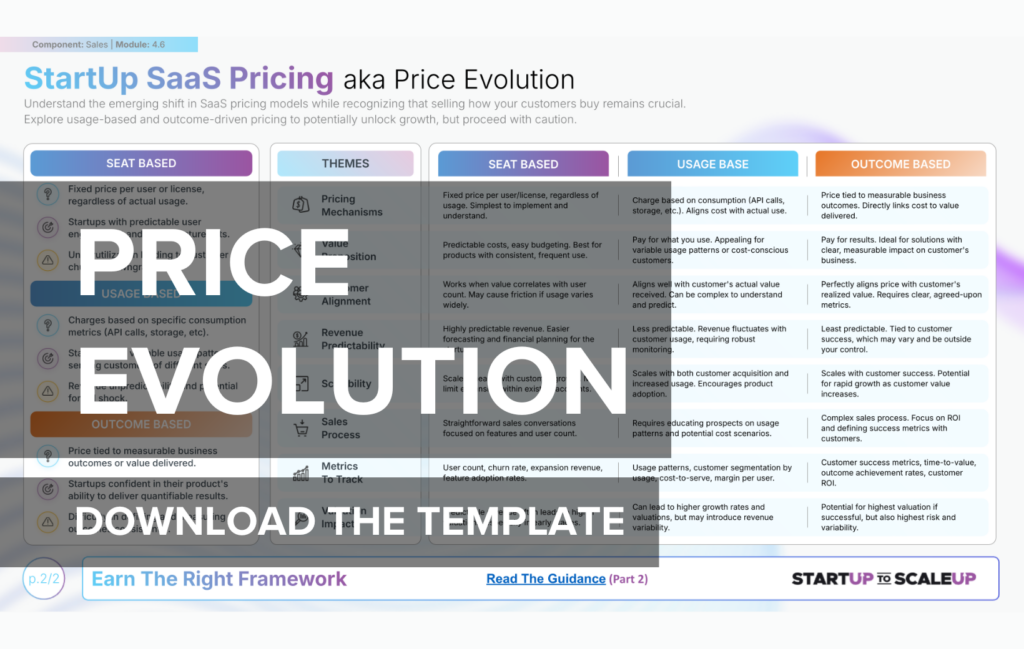How Can Your Startup SaaS Pricing Model Adapt?
Why are SaaS companies shifting away from traditional seat-based pricing?
SaaS companies are moving away from seat-based pricing for several reasons:
- Value alignment: Seat-based pricing often fails to reflect the true value provided by the product.
- Customer demand: Clients are pushing for pricing that matches their actual usage and realized value.
- Competitive pressure: Industry leaders like Salesforce are experimenting with alternative pricing models.
- Technical advancements: Improved analytics make it easier to implement and manage usage-based pricing.
This shift allows for better alignment between the value delivered and the price charged, potentially leading to higher customer satisfaction and retention.
What are the key differences between usage-based and outcome-based pricing?
Usage-based and outcome-based pricing differ in their focus:
Usage-based pricing:
- Charges based on the volume or quantity of resources consumed
- Examples: API calls, time used, tokens, actions, or edits
- Directly ties cost to utilization of the product
Outcome-based pricing:
- Charges based on specific, measurable results achieved by the service
- Examples: Autonomous resolutions, completed tasks, or delivered packages
- Focuses on the value or outcomes produced for the customer
Both models aim to align pricing more closely with the value provided, but outcome-based pricing takes this a step further by directly tying costs to tangible results.
How can startups implement new pricing models without alienating customers?
To implement new pricing models without alienating customers:
- Start small: Offer a “pay as you go” option alongside existing seat-based models.
- Educate customers: Clearly explain the benefits of the new pricing model.
- Provide transparency: Offer tools like pricing calculators to help customers understand costs.
- Ensure predictability: Address concerns about variable spending with caps or estimates.
- Offer transition periods: Allow customers to gradually move to the new model.
- Focus on value: Frame pricing around the value of outcomes, not just usage.
- Gather feedback: Continuously collect and act on customer input about the new model.
The key is to make the transition gradual and beneficial for customers, while clearly communicating the value proposition.
What are the potential benefits of usage or outcome-based pricing for startups?
Usage or outcome-based pricing can offer several benefits:
- Revenue growth: Can lead to higher overall revenue as customers scale their usage.
- Customer alignment: Better reflects the value customers receive from the product.
- Market expansion: Can attract customers who might be hesitant about fixed-cost models.
- Competitive advantage: Differentiates the offering in a crowded market.
- Lower entry barrier: Allows customers to start small and grow their usage over time.
- Data insights: Provides valuable data on how customers use and value the product.
- Incentive alignment: Encourages the startup to continuously improve the product to drive usage or outcomes.
These models can unlock new growth vectors and customer segments, potentially leading to faster scaling.
What challenges might startups face when shifting to usage or outcome-based pricing?
Challenges in shifting to new pricing models include:
- Revenue predictability: Variable usage can make revenue forecasting more difficult.
- Customer education: Explaining new models may require significant effort and resources.
- Technical implementation: Tracking usage or outcomes accurately can be technically challenging.
- Cash flow management: Variable revenue can complicate financial planning and operations.
- Sales team adaptation: Requires retraining sales teams on new value propositions and pricing structures.
- Customer resistance: Some customers may prefer the predictability of seat-based pricing.
- Pricing complexity: Balancing simplicity with accurate value reflection can be challenging.
Startups need to carefully weigh these challenges against the potential benefits when considering a pricing model shift.
How can startups determine the right pricing model for their SaaS product?
To determine the right pricing model:
- Understand customer value: Identify how customers derive value from your product.
- Analyze usage patterns: Study how different customers use your product.
- Consider your costs: Ensure the model covers your costs and allows for profit.
- Evaluate competitors: Understand how similar products in the market are priced.
- Test different models: Use A/B testing to trial different pricing structures.
- Gather customer feedback: Directly ask customers about their pricing preferences.
- Assess technical feasibility: Ensure you can accurately track and bill for your chosen model.
The goal is to find a model that aligns with your product’s value proposition, customer needs, and business goals.
Choosing the right pricing model is crucial for SaaS startups. While seat-based pricing has been the norm, many companies are now exploring usage-based and outcome-based models. These new approaches can better align pricing with the value delivered to customers, potentially leading to higher revenue and customer satisfaction.
Challenges
Implementing new pricing models comes with challenges. It requires careful planning, customer education, and potentially significant technical changes. Startups should consider starting with hybrid models, offering new pricing options alongside traditional ones to ease the transition.
Ultimately, the best pricing model depends on your specific product, target market, and business goals. It should reflect the value you provide, be easy for customers to understand, and support your growth objectives. Regular review and adjustment of your pricing strategy is essential as your product and market evolve.
Not just about numbers
Remember, pricing is not just about numbers – it’s a key part of your value proposition and customer relationship. Whatever model you choose, focus on clearly communicating the value and ensuring that customers feel they’re getting a fair deal. This approach will help build long-term relationships and drive sustainable growth for your SaaS startup.
